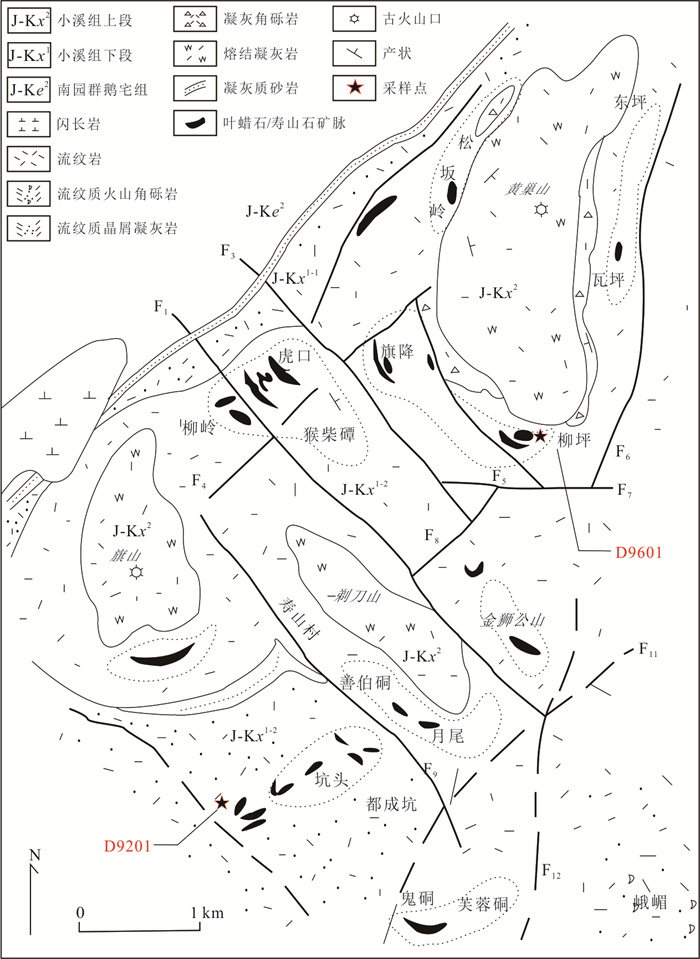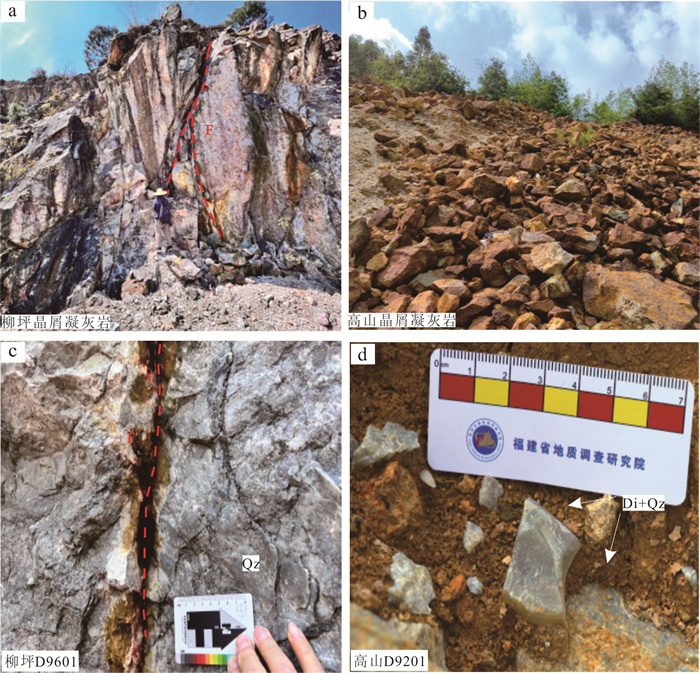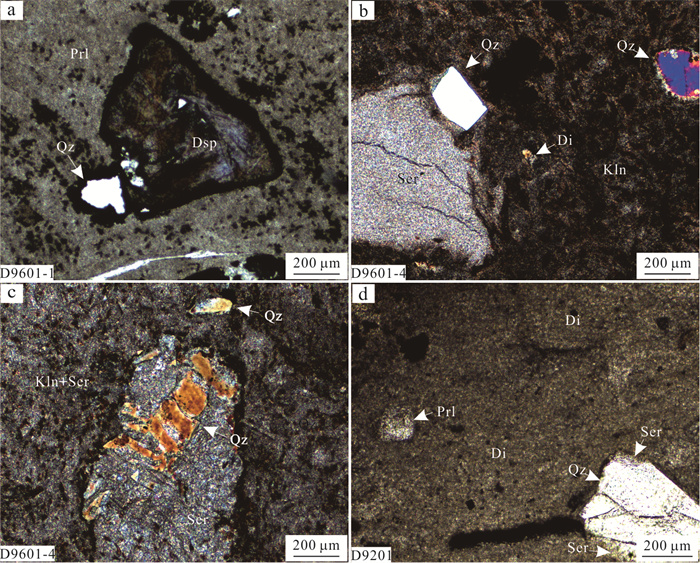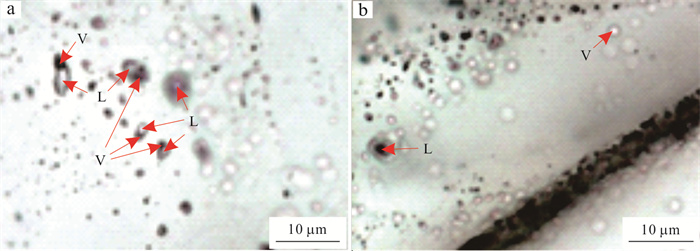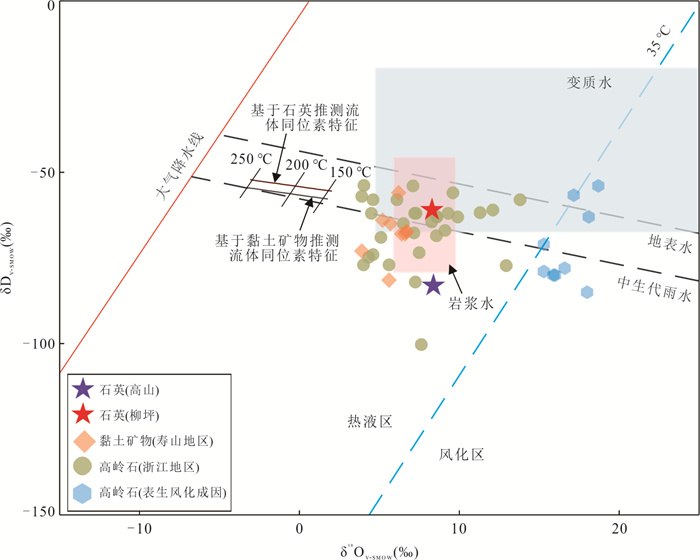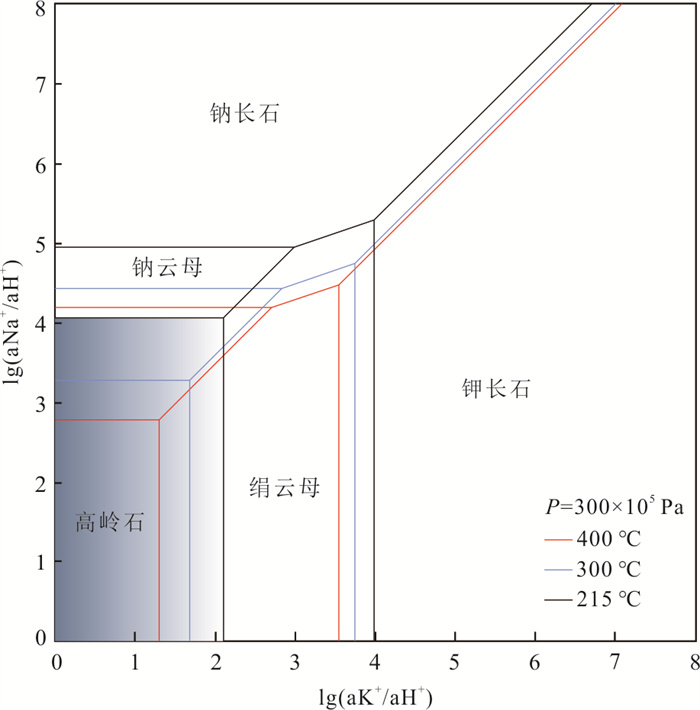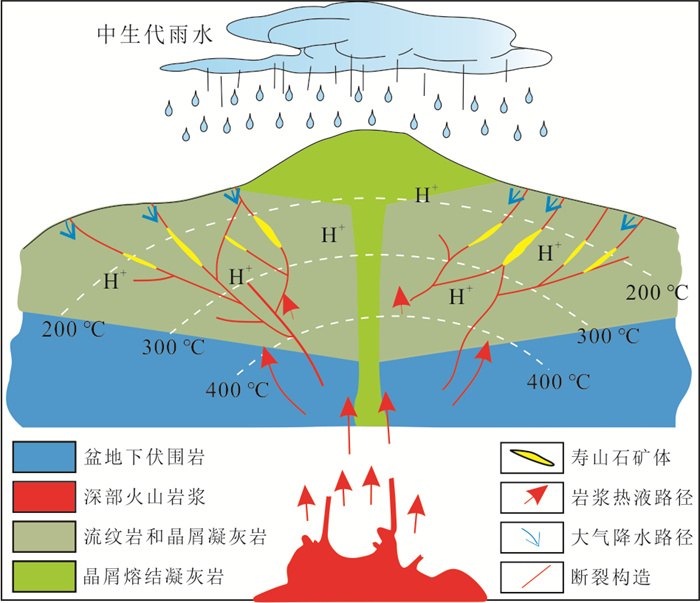Fluid Inclusions and H-O Isotopic Characterization of Shoushan Stone Deposits in Fuzhou and Its Significance for Genesis of Deposits
-
摘要: 中国四大雕刻名石之一的福州寿山石是酸性火山岩与热液发生水岩反应的产物,因此成矿流体特征是寿山石形成机理研究和建立正确成矿模式与勘查模型的关键.对产于福州寿山地区的热液石英进行了流体包裹体测试和H-O同位素分析,并利用热力学工具定量探讨了富含高岭石族矿物寿山石形成所需的条件.用于测试的热液石英富含气液两相包裹体,两件采自柳坪矿区的样品获得的均一温度分别为197 ℃和211 ℃,采自高山矿区的样品获得的均一温度为245 ℃.H-O同位素测试获得石英中的δ18OV-SMOW的值为8.3‰和8.4‰,δDV-SMOW的值为-61‰和-83‰.结合收集获得的高岭石H-O同位素数据,最终推测出不同平衡温度条件下(150 ℃、200 ℃、250 ℃)成矿流体的H-O同位素特征,结果表明寿山石成矿流体应是岩浆水和大气降水混合的产物.正是大气降水的加入让原来高温岩浆热液的温度、盐度、pH值等特征变得更加适合形成黏土矿物.而长时间发生的水岩反应有利于酸性火山岩充分蚀变,形成种类丰富多样的寿山石.本文进一步完善了寿山石的矿床成因模型,同时为浅成低温热液蚀变成因的金属和非金属矿床勘查工作提供启示.Abstract: As one of the four most famous carving stones in China, Shoushan stone is mainly produced in the Fuzhou volcanic basin and formed by alteration between acidic volcanic rocks and hydrothermal fluids. The characteristics of ore-forming fluid are the key to understanding the mineralization and exploration model. The hydrothermal quartz from Shoushan stone deposit was sampled for the experiment of fluid inclusions and H-O isotopes. The thermodynamic tool is also adopted to quantify the conditions for the formation of Shoushan stone containing kaolinite group minerals. All fluid inclusions in quartz consist of volatile-liquid phases. The homogenization temperatures are 197 ℃ and 211 ℃ for samples from Liuping sample, and 245 ℃ for that from Gaoshan. The δ18OV-SMOW values of quartz are 8.3‰ and 8.4‰, and the δDV-SMOW values of quartz are -61‰ and -83‰. Combined with the H-O isotope results of kaolinite from previous research, the H-O isotope of fluid is calculated theoretically under different temperatures (150 ℃, 200 ℃ and 250 ℃), which demonstrates that the ore-forming fluid is a mixture of magmatic and meteoric water. By the addition of meteoric water, the temperature, salinity and pH of magmatic-hydrothermal fluids, hydrothermal fluids are made more suitable for the formation of clay minerals. Then, the long-term water-rock reaction leads to the sufficient alternation of acidic volcanic rocks, forming a variety of Shoushan stones. This study improves the mineralization model of Shoushan stone and provides insights into the exploration of metallic and non-metallic deposits caused by epithermal hydrothermal alteration.
-
Key words:
- Shoushan stone /
- fluid inclusion /
- H-O isotope /
- fluid source /
- mineralization condition /
- ore deposit
-
图 1 福建省火山盆地和叶蜡石矿床分布
Fig. 1. Distribution of volcanic basin and pyrophyllite deposits in Fujian Province
图 2 福州寿山地区地质构造简图(据高天钧等, 1997修改)
Fig. 2. Geological and structural sketch map of Shoushan area, Fuzhou (modified after Gao et al., 1997)
图 7 福建寿山地区和浙江地区黏土矿物氢‒氧同位素组成
Fig. 7. The H-O isotopes of clay minerals from Shoushan and other areas in Zhejiang and Fujian provinces
图 9 福州寿山石成矿模式示意图(据高天钧等, 1997修改)
Fig. 9. Sketch map showing the metallogenic model of the Shoushan stone in Fuzhou City (modified after Gao et al., 1997)
表 1 寿山地区石英中流体包裹体的显微温度结果
Table 1. Microthermometric results of fluid inclusion in quartz from the Shoushan area
样品号 采样地 矿物 气相百分比(%) 大小
(μm×μm)冰点温度
Tmi(℃)均一温度
Th(℃)盐度 密度 W(%) ρ(g/cm3) D9601-4 柳坪 石英 5 8×4 ‒1.3 213.4 2.26 1.46 5 6×4 ‒1.4 209.1 2.42 1.40 10 10×6 ‒1.1 211.5 1.92 1.44 5 8×4 ‒2.6 174.4 4.33 0.93 10 20×10 ‒1.7 178.6 2.91 0.99 D9601‒1 柳坪 石英 10 8×10 ‒1.2 196.8 2.09 1.23 5 8×8 ‒1 211.6 1.75 1.44 10 6×8 ‒1.3 216.5 2.26 1.51 10 8×8 ‒0.8 198.8 1.42 1.26 5 6×6 ‒0.5 212.9 0.90 1.47 10 6×10 ‒0.6 220.8 1.07 1.58 10 10×16 ‒0.9 219 1.59 1.55 D9201 高山 石英 10 6×12 ‒1 235.8 1.75 1.82 10 6×14 ‒1.2 253.3 2.09 2.11 表 2 福州寿山地区不同矿物的氢氧同位素
Table 2. The H-O isotopes of various minerals from Shoushan area, Fuzhou
序号 采样位置 矿物名称 δ18OV-SMOW(‰) δDV-SMOW(‰) 数据来源 1 柳坪 石英 8.3 ‒61 本文 2 高山 石英 8.4 ‒83.1 平均值 8.3 ‒72.1 3 旗降 地开石 5.6 ‒81.5 杨献忠等, 1993 4 高山 地开石 6.7 ‒67.3 杨献忠等, 1993 5 高山 地开石 3.9 ‒73 董晋琨, 2008 6 旗降 高岭石 6.2 ‒56 董晋琨, 2008 7 6.6 ‒68 甘怡绚, 2001 8 6.4 ‒68 9 寿山 地开石 5.2 ‒64 10 5.7 ‒65 11 6.7 ‒67.3 陈鹤年等, 1988 平均值 5.9 ‒67.8 表 3 不同温压条件下蚀变反应的平衡常数
Table 3. Equilibrium constants of alteration reactions in different temperature and pressure conditions
反应方程 lg K T=215 ℃ T=300 ℃ T=400℃ 130×105 Pa 300×105 Pa 130×105 Pa 300×105 Pa 300×105 Pa NaAlSi3O8+K+=KAlSi3O8+Na+ 1.29 1.30 0.98 0.99 0.92 (钠长石) (钾长石) 3KAlSi3O8+2H+=KAl2[AlSi3O10](OH)2+6SiO2+2K+ 7.93 7.99 7.44 7.51 7.13 (钾长石) (绢云母) 3NaAlSi3O8+K++2H+=KAl2[AlSi3O10](OH)2+6SiO2+3Na+ 11.81 11.88 10.37 10.47 9.88 (钠长石) (绢云母) 2KAl2[AlSi3O10](OH)2+2H++3H2O=3Al2[Si2O5](OH)4+2K+ 4.15 4.20 3.30 3.38 2.62 (绢云母) (高岭石) KAl2[AlSi3O10](OH)2+Na+=NaAl2[AlSi3O10](OH)2+K+ ‒1.96 ‒1.97 ‒1.58 ‒1.59 ‒1.47 (绢云母) (钠云母) 3NaAlSi3O8+2H+=NaAl2[AlSi3O10](OH)2+6SiO2+2Na+ 9.85 9.91 8.79 8.87 8.40 (钠长石) (钠云母) 2NaAl2[AlSi3O10](OH)2+2H++3H2O=3Al2[Si2O5](OH)4+2Na+ 8.07 8.13 6.47 6.57 5.57 (钠云母) (高岭石) -
Al Ani, T., Sarapää, O., 2008. Clay and Clay Mineralogy. Report of Geographical Area GTK Espoo. Geological Survey of Finland, Espoo. Bodnar, R. J., 1993. Revised Equation and Table for Determining the Freezing Point Depression of H2O-Nacl Solutions. Geochimica et Cosmochimica Acta, 57(3): 683-684. https://doi.org/10.1016/0016-7037(93)90378-A Chao, W. W., Xu, D. R., Li, Z. H., et al., 2024. Characteristics and Geological Implications of Mineral Chemistry and Fluid Inclusions in Huxu Au-Pb-Zn Ore Deposit, Jiangxi Province. Earth Science, 49(4): 1292-1306 (in Chinese with English abstract). Chen, H. N., Wu, Q. H., He, J. R., et al., 1988. Basic Characteristics of Mesozoic Volcanic Genesis Non- Metallic Mineral Deposits in Zhejiang, Fujian, and Jiangxi Regions. Geological Publishing House, Beijing, 488 (in Chinese). Chen, R. B., Wei, X., 2017. Geological Conditions of Shoushan Stone Mineralization and Prediction of Prospective Target Areas. Academic Symposium on the Geological Genesis and Characteristics of Beryl Stones in Shoushan Stone, Fujian Province. Geological Society of Fujian, Fuzhou (in Chinese). Chen, R. S., Li, Y. J., 2017. The Study of Geological Conditions and Genesis of Shoushan Stone Mineralization: Issues and Challenges. Academic Symposium on the Geological Genesis and Characteristics of Beryl Stones in Shoushan Stone, Fujian Province. Geological Society of Fujian, Fuzhou (in Chinese). Chen, T., Tang, L. L., Lu, W., et al., 2008. Study on Colour Causing of Peach Blossom Stone from Gao Mountain, Shoushan County, Fujian Province. Journal of Gems & Gemmology, 10(3): 1-3 (in Chinese with English abstract). Dong, J. K., 2008. Mineralogical Study and Genetic Analysis of the Shoushan Stone Deposit in Fujian (Dissertation). China University of Geosciences, Beijing (in Chinese with English abstract). Gan, Y. X., 2001. The Mineralogy, Geochemistry, and Genesis of Shoushan Stone Deposits (Dissertation). Peking University, Beijing (in Chinese with English abstract). Gao, T. J., Zhang, Z. L., Liu, Z. X., 1997. The Minerogenic Conditions and Prospects for Mineral Exploration of the Shoushan Stone (Agalmatolite) in Fujian Province. Geology of Fujian, 16(3): 110-131 (in Chinese with English abstract). Hedenquist, J. W., Arribas, A., 2022. Exploration Implications of Multiple Formation Environments of Advanced Argillic Minerals. Economic Geology, 117(3): 609-643. https://doi.org/10.5382/econgeo.4880 Johnson, J. W., Oelkers, E. H., Helgeson, H. C., 1992. SUPCRT92: A Software Package for Calculating the Standard Molal Thermodynamic Properties of Minerals, Gases, Aqueous Species, and Reactions from 1 to 5 000 Bar and 0 to 1 000 ℃. Computers & Geosciences, 18(7): 899-947. https://doi.org/10.1016/0098-3004(92)90029-Q Li, Y. J., 2005. On the Mineral Constituent and Characteristics of Shoushan Stone. Geology of Fujian, 24(2): 79-89 (in Chinese with English abstract). Li, Y. J., 2018. Comparison for Metallogenic Geological Condition of Four Type Chinese Stamp Stones. Geology of Fujian, 37(1): 1-12 (in Chinese with English abstract). Li, Y. J., Chen, R. S., Yang, Z., et al., 2022. Alunite 40Ar/39Ar Dating of Gaoshan Deposit, Fujian Province and Its Limitation of the Mineralization Age of Shoushan Stone. Journal of Gems & Gemmology, 24(5): 44-54 (in Chinese with English abstract). Li, Y. J., Zhu, L. Y., Xu, W., et al., 2022. Stratigraphic Section and Geochronological Studies of the Shoushan Basin, Fujian Province, South China, and Its Implications for the Mineralization of Shoushan Stone. Minerals, 12(12): 1542. https://doi.org/10.3390/min12121542 Lin, M., 2011. New Progress on the Study of Stratum Sequence, Rock Association and Epoch of the Xiaoxi Formation in Fujian Province. Geology and Exploration, 47(4): 555-565 (in Chinese with English abstract). Lin, M., 2017. Study on the Characteristics of Volcanism of Volcanic Eruptive Basins and the Relation to Pyrophyllite Ore in Shoushan Area, Fujian Province. Geology of Fujian, 36(4): 251-261 (in Chinese with English abstract). Liu, B., Duan, G. X., 1987. The Density and Isochoric Formulae for NaCl-H2O Fluid Inclusions (Salinity≤ 25 wt%) and Their Applications. Acta Mineralogica Sinica, 7(4): 345-352 (in Chinese with English abstract). Pan, J. Y., Ni, P., Chi, Z., et al., 2019. Alunite 40Ar/39Ar and Zircon U-Pb Constraints on the Magmatic- Hydrothermal History of the Zijinshan High-Sulfidation Epithermal Cu-Au Deposit and the Adjacent Luoboling Porphyry Cu-Mo Deposit, South China: Implications for Their Genetic Association. Economic Geology, 114(4): 667-695. https://doi.org/10.5382/econgeo.4658 Simmons, S. F., Browne, P. R. L., 2000. Hydrothermal Minerals and Precious Metals in the Broadlands-Ohaaki Geothermal System: Implications for Understanding Low-Sulfidation Epithermal Environments. Economic Geology, 95(5): 971-999. https://doi.org/10.2113/gsecongeo.95.5.971 Tang, D. P., Wu, L. W., Zheng, Z. T., et al., 2012. An Explanation for the Provincial Standard of Larderite. Journal of Gems & Gemmology, 14(3): 48-52 (in Chinese with English abstract). Tang, D. P., Zheng, Z. T., 1999. Mineralogy and Gemmology of Shoushan Stone. Journal of Gems & Gemmology, 1(4): 28-36 (in Chinese with English abstract). Taylor, H. P., 1997. Oxygen and Hydrogen Isotope Relationships in Hydrothermal Mineral Deposits. In: Barnes, H. L., ed., Geochemistry of Hydrothermal Deposits. John Wiley and Sons, New York. Wu, X. F., Cui, W. Y., 1999. A Mineralogical and Petrographical Study of Shoushan Stone (Agalmatolite). Acta Petrrologica et Mineralogica, 18(2): 186-192 (in Chinese with English abstract). Xiao, F., Fan, F. P., Xing, G. F., et al., 2022. Late Jurassic Epithermal Mineralization of Shitouban Au Deposit, Dehua-Youxi Area, Southeast China: Quartz Rb Sr Dating, Fluid Inclusions, and H-O-S-Pb-Sr Isotope Analyses. Journal of Geochemical Exploration, 236: 106964. https://doi.org/10.1016/j.gexplo.2022.106964 Xu, B. T., 1991. Hydrogen and Oxygen Isotopic Compositions of Dickite Clay and Their Forming Condition in Zhejiang Province. Bulletin of Science and Technology, 7(6): 306-309 (in Chinese with English abstract). Yang, X. Z., Huang, G. Z., Li, P. Y., et al., 1993. Polytypes and Transformation of Pyrophyllite from the Shoushan Pyrophyllite Deposit. Geology of Fujian, 12(3): 172-181 (in Chinese with English abstract). Ye, K. K., 2019. Distribution and Types of Pyrophyllite Deposits in Fujian Province. Metallurgy and Materials, 11(6): 181, 183 (in Chinese with English abstract). Ye, Z. F., Ye, F., Miao, R. G., et al., 2022. Ore Genesis of Pyrophyllite Deposit in Zhejiang-Fujian Area. Mineral Deposits, 41(6): 1258-1273 (in Chinese with English abstract). Yu, M. G., Hong, W. T., Yang, Z. L., et al., 2021. Classification of Yanshanian Volcanic Cycle and the Related Mineralization in the Coast Area of Southeastern China. Geological Bulletin of China, 40(6): 845-863 (in Chinese with English abstract). Zhang, S. Y., Zhang, H. F., 2020. Genesis of the Baiyun Pyrophyllite Deposit in the Central Taihang Mountain, China: Implications for Gold Mineralization in Wall Rocks. Ore Geology Reviews, 120: 103313. https://doi.org/10.1016/j.oregeorev.2020.103313 Zheng, Y., 2022. Large-Scaled Structure-Alteration-Mineralization Mapping of the Hydrothermal Deposits: Basic Principle and Precautions. Earth Science, 47(10): 3603-3615 (in Chinese with English abstract). Zhou, X. M., Li, W. X., 2000. Origin of Late Mesozoic Igneous Rocks in Southeastern China: Implications for Lithosphere Subduction and Underplating of Mafic Magmas. Tectonophysics, 326(3-4): 269-287. https://doi.org/10.1016/S0040-1951(00)00120-7 Zhu, L. Y., Jiang, S. Y., Chen, R. S., et al., 2019. Origin of the Shangfang Tungsten Deposit in the Fujian Province of Southeast China: Evidence from Scheelite Sm-Nd Geochronology, H-O Isotopes and Fluid Inclusions Studies. Minerals, 9(11): 713. https://doi.org/10.3390/min9110713 抄尉尉, 许德如, 李增华, 等, 2024. 江西虎圩金铅锌矿床矿物化学、流体包裹体特征及地质意义. 地球科学, 49(4): 1292-1306. doi: 10.3799/dqkx.2022.305 陈鹤年, 巫全淮, 贺菊瑞, 等, 1988. 浙闽赣地区中生代火山成因非金属矿床基本特征. 北京: 地质出版社, 488. 陈仁表, 魏鑫. 2017. 寿山石成矿地质条件及找矿靶区预测. 福建省寿山石地质成因及宝玉石特性学术研讨会. 福建省地质学会, 福州. 陈润生, 李玉娟. 2017. 寿山石成矿地质条件及成因研究: 问题与难点. 福建省寿山石地质成因及宝玉石特性学术研讨会. 福建省地质学会, 福州. 陈涛, 唐亮亮, 鲁纬, 等, 2008. 福建寿山高山桃花石的颜色成因研究. 宝石和宝石学杂志, 10(3): 1-3. 董晋琨, 2008. 福建寿山石矿床的矿物学研究和成因分析(硕士学位论文). 北京: 中国地质大学. 甘怡绚. 2001. 寿山石矿床矿物学、地球化学及其成因(博士学位论文). 北京: 北京大学. 高天钧, 张智亮, 刘志逊, 1997. 寿山石成矿地质条件及找矿前景. 福建地质, 16(3): 110-131. 李玉娟, 2005. 寿山石的矿物组分和特征. 福建地质, 24(2): 79-89. 李玉娟, 2018. 我国四大图章石成矿地质条件比较研究. 福建地质, 37(1): 1-12. 李玉娟, 陈润生, 杨仲, 等, 2022. 福建高山矿区明矾石40Ar/39Ar定年及其对寿山石成矿时代的限定. 宝石和宝石学杂志(中英文), 24(5): 44-54. 林敏, 2011. 福建小溪组地层层序、岩石组合及时代研究新进展. 地质与勘探, 47(4): 555-565. 林敏, 2017. 福建寿山火山喷发盆地火山作用特征及与叶蜡石成矿关系探讨. 福建地质, 36(4): 251-261. 刘斌, 段光贤, 1987. NaCl-H2O溶液包裹体的密度式和等容式及其应用. 矿物学报, 7(4): 345-352. 汤德平, 吴立旺, 郑宗坦, 等, 2012. 寿山石新地方标准解析. 宝石和宝石学杂志, 14(3): 48-52. 汤德平, 郑宗坦, 1999. 寿山石的矿物组成与宝石学研究. 宝石和宝石学杂志, 1(4): 28-36. 武新逢, 崔文元, 1999. 寿山石的矿物学研究. 岩石矿物学杂志, 18(2): 186-192. 徐步台, 1991. 浙江地开石粘土的氢、氧同位素组成及其形成条件. 科技通报, 7(6): 306-309. 杨献忠, 黄光昭, 李佩玉, 等, 1993. 寿山叶蜡石矿床中叶蜡石的多型及其转变. 福建地质, 12(3): 172-181. 叶孔凯, 2019. 福建省叶蜡石矿床分布及其类型. 冶金与材料, 11(6): 181, 183. 叶泽富, 叶帆, 缪仁谷, 等, 2022. 浙闽地区叶蜡石矿床成矿规律研究. 矿床地质, 41(6): 1258-1273. 余明刚, 洪文涛, 杨祝良, 等, 2021. 东南沿海燕山期火山活动旋回划分及其成矿规律. 地质通报, 40(6): 845-863. 郑义, 2022. 热液矿床超大比例尺构造‒蚀变‒矿化填图: 基本原理与注意事项. 地球科学, 47(10): 3603-3615. doi: 10.3799/dqkx.2022.295 -









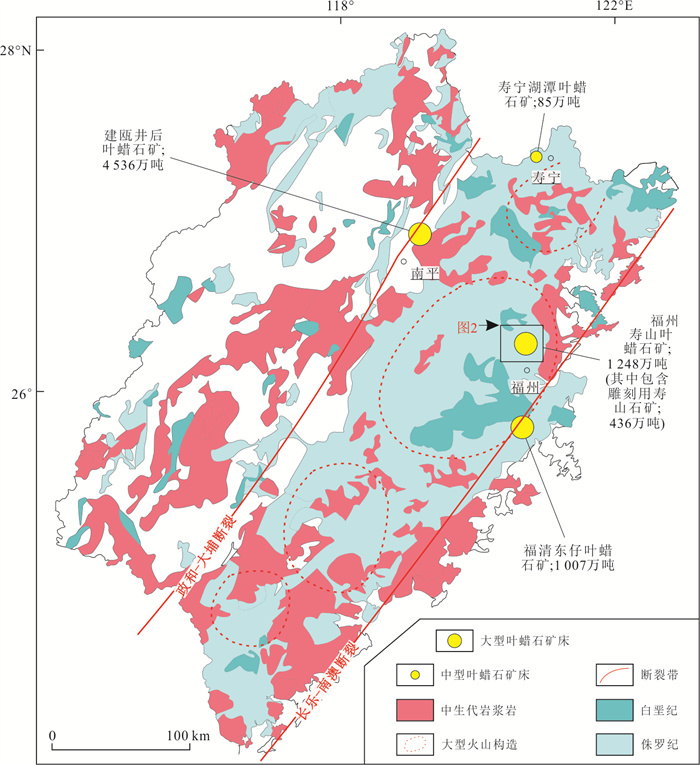
 下载:
下载:
